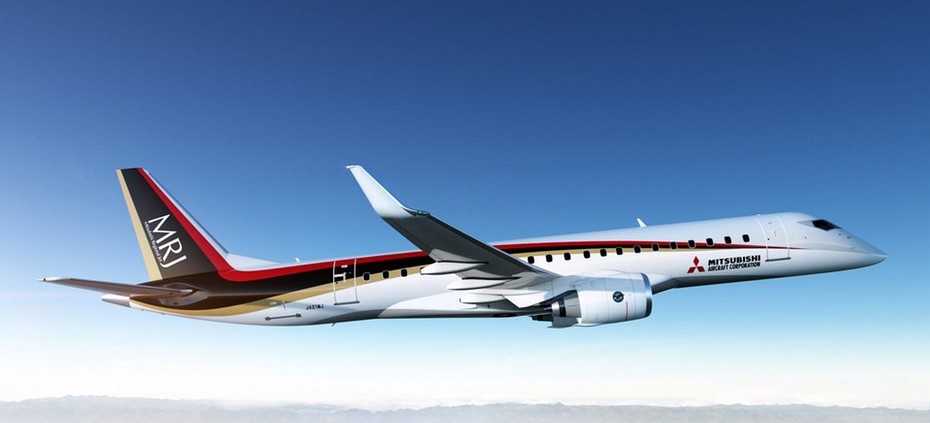MRJ Mitsubishi Regional Jet First Flight
NAGOYA, Japan—After a successful first flight of its regional jet on Wednesday,Mitsubishi Heavy Industries Ltd. is hoping to step up sales against competition from established aircraft makers and upstarts.
The gull-nosed Mitsubishi Regional Jet, the most prominent aircraft to carry the Mitsubishi name since the Zero fighter of World War II, flew over Japan and the Pacific coast for nearly an hour and a half. Escorted by Japanese military planes, it reached speeds of up to 280 kilometers an hour (174 miles an hour) and altitudes of up to 15,000 feet.
‘’Today was very windy,” but the plane remained mostly stable, chief test pilot Yoshiyuki Yasumura said later at a news conference. “During the approach it swayed a bit, but we were able to address this.’’
The jet being developed by a subsidiary of Mitsubishi Heavy is designed for short-haul flights, a market in which it will compete against Embraer SA of Brazil and BombardierInc. of Canada.
Ascend Flightglobal, a consulting firm, estimates that carriers will order 4,360 regional jets through 2034 valued at around $135 billion. It predicts that Mitsubishi will capture 27% of that market in unit and value terms.
Now that Mitsubishi has demonstrated that the plane can fly, airlines “that have taken a wait-and-see approach can negotiate acquisition of the aircraft with increased confidence,” said Rob Morris, head of consultancy at Ascend Flightglobal in London.
Mitsubishi has touted the aircraft as offering greater fuel efficiency and comfort than existing regional jets.
It has plenty of company in seeking airlines’ business. Embraer and Bombardier are upgrading their airliners. Sukhoi Civil Aircraft Co. of Russia makes a regional jet and Commercial Aircraft Corp. of China is developing one.
The Mitsubishi Regional Jet will come in versions seating roughly 70 and 90 passengers, with a list price of $46.3 million and $47.3 million, respectively. Mitsubishi said demand will be driven by airlines moving up from 50-seat planes or scaling back from larger ones.
Hiromichi Morimoto, president of Mitsubishi Aircraft Corp., the unit that is developing the aircraft, said Wednesday the company is considering a third version that would seat 100 passengers—pushing it closer in size to the Boeing 737 and Airbus A320, which seat over 100 passengers.
Bombardier has been focusing on developing larger aircraft to compete against the 737 and A320 series.
At Wednesday’s maiden flight of the Mitsubishi jet, hundreds of reporters, business leaders and air-travel enthusiasts gathered at Nagoya Airport, reflecting the jet’s status as a project of national interest for Japan. Minority investors include Toyota MotorCorp., and a range of Japanese companies are supplying parts.
Chief Cabinet Secretary Yoshihide Suga called it “the dawn of a new era for Japan’s aviation industry,’’ saying the government would help promote the jet.
The aircraft was originally supposed to have its first test flight more than five years ago, but the program suffered a series of delays. Mitsubishi said it would deliver the first aircraft in 2017 to All Nippon Airways Co. The carrier has ordered 15 of the planes and taken options for 10 more.
Other customers include Trans States Holdings, Sky West Inc., Eastern Air Lines Group Inc., Air Mandalay Ltd. and Japan Airlines Co. In all, Mitsubishi said it has firm orders for 223 planes and options or purchase rights for 184 more.
The aircraft still needs to go through thousands of hours of flight testing and regulatory certification steps in Japan and the U.S.
The Mitsubishi jet, powered by Pratt & Whitney engines, is the first commercial airliner built in Japan since the propeller-driven YS-11, which was made by a consortium of Japanese companies in the 1960s and 70s.
Mitsubishi Heavy makes aircraft for Japan’s military and it has been a major subcontractor on commercial airplanes like the Boeing 787. “The Japanese aviation industry has been dependent on government demand, mainly the defense ministry, but now it has entered the phase of doing business with the private sector,’’ said aerospace analyst Yoshitomo Aoki.



